文学术语
- 格式:doc
- 大小:62.50 KB
- 文档页数:10
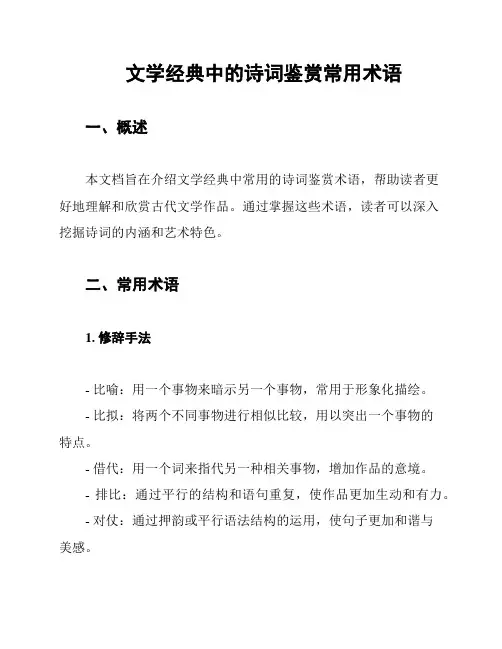
文学经典中的诗词鉴赏常用术语一、概述本文档旨在介绍文学经典中常用的诗词鉴赏术语,帮助读者更好地理解和欣赏古代文学作品。
通过掌握这些术语,读者可以深入挖掘诗词的内涵和艺术特色。
二、常用术语1. 修辞手法- 比喻:用一个事物来暗示另一个事物,常用于形象化描绘。
- 比拟:将两个不同事物进行相似比较,用以突出一个事物的特点。
- 借代:用一个词来指代另一种相关事物,增加作品的意境。
- 排比:通过平行的结构和语句重复,使作品更加生动和有力。
- 对仗:通过押韵或平行语法结构的运用,使句子更加和谐与美感。
2. 诗体类型- 古诗:古代中国文学中的一种诗体,以五言或七言为最常见的体制。
- 词:古代文学中的韵文表达形式,以表达作者的个人感情为主。
- 绝句:一种四行诗,每行五、七个字,形式简洁。
- 律诗:古代又称骈体诗,有严格的字数限制和特定的格律要求。
3. 修辞格- 典型比喻:明确指出比喻对象和被比喻对象。
- 间接比喻:通过暗示来表达比喻。
- 拟人:将非人的事物赋予人的形象和行为。
- 擬音:模拟物体的声音,增加描写的形象感。
- 倍数:通过增加倍数的描写来强调或夸张某种特征。
4. 主题与意境- 自然景色:描绘自然景色,如山水、花草等,寄托情感和思考。
- 爱情:表达爱情的美好与痴迷,揭示人性中的情感纠葛。
- 思乡:表现对故乡的深情怀念和思恋之情。
- 心灵与哲思:思考生命、时间、道德和人生意义等抽象问题。
三、总结本文档介绍了文学经典中常用的诗词鉴赏术语,包括修辞手法、诗体类型、修辞格和主题与意境等。
熟悉这些术语有助于我们更好地理解和欣赏古代文学作品的深层内涵和艺术特点。
希望读者通过本文档的学习,能够在鉴赏古代诗词时更加游刃有余。
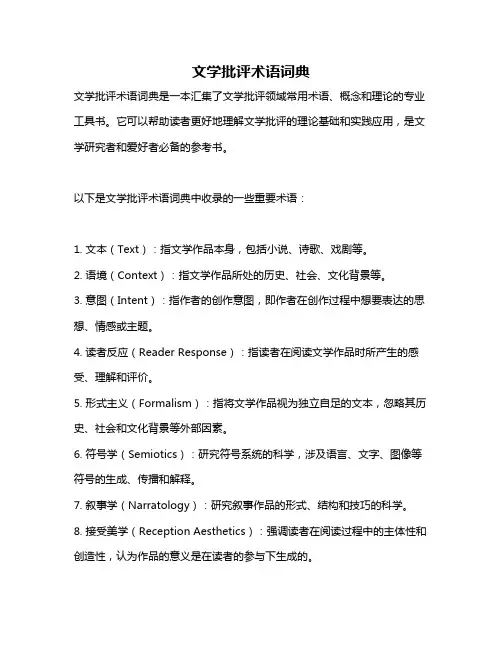
文学批评术语词典
文学批评术语词典是一本汇集了文学批评领域常用术语、概念和理论的专业工具书。
它可以帮助读者更好地理解文学批评的理论基础和实践应用,是文学研究者和爱好者必备的参考书。
以下是文学批评术语词典中收录的一些重要术语:
1. 文本(Text):指文学作品本身,包括小说、诗歌、戏剧等。
2. 语境(Context):指文学作品所处的历史、社会、文化背景等。
3. 意图(Intent):指作者的创作意图,即作者在创作过程中想要表达的思想、情感或主题。
4. 读者反应(Reader Response):指读者在阅读文学作品时所产生的感受、理解和评价。
5. 形式主义(Formalism):指将文学作品视为独立自足的文本,忽略其历史、社会和文化背景等外部因素。
6. 符号学(Semiotics):研究符号系统的科学,涉及语言、文字、图像等符号的生成、传播和解释。
7. 叙事学(Narratology):研究叙事作品的形式、结构和技巧的科学。
8. 接受美学(Reception Aesthetics):强调读者在阅读过程中的主体性和创造性,认为作品的意义是在读者的参与下生成的。
9. 结构主义(Structuralism):将文学作品视为一个整体,研究其内在的结构、关系和规律。
10. 后结构主义(Poststructuralism):对结构主义的批判和超越,强调个体主体性和文本的开放性。
这只是一小部分文学批评术语的示例,实际上,文学批评领域的术语极为丰富多样。
文学批评术语词典将会对深入理解文学批评的概念和理论提供极大的帮助。
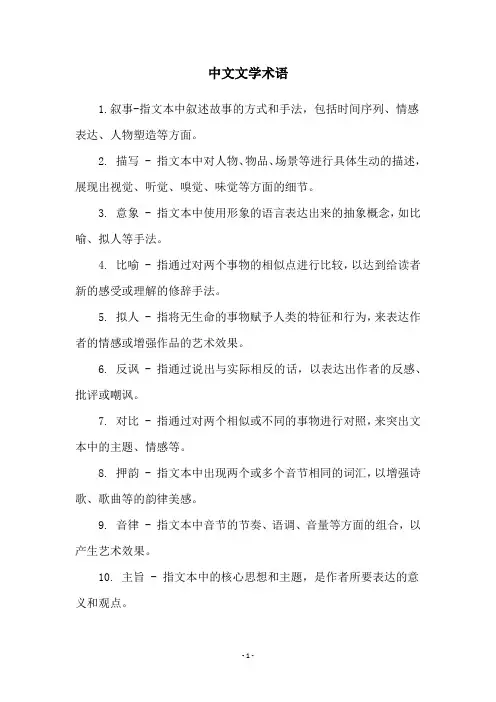
中文文学术语
1.叙事-指文本中叙述故事的方式和手法,包括时间序列、情感表达、人物塑造等方面。
2. 描写 - 指文本中对人物、物品、场景等进行具体生动的描述,展现出视觉、听觉、嗅觉、味觉等方面的细节。
3. 意象 - 指文本中使用形象的语言表达出来的抽象概念,如比喻、拟人等手法。
4. 比喻 - 指通过对两个事物的相似点进行比较,以达到给读者新的感受或理解的修辞手法。
5. 拟人 - 指将无生命的事物赋予人类的特征和行为,来表达作者的情感或增强作品的艺术效果。
6. 反讽 - 指通过说出与实际相反的话,以表达出作者的反感、批评或嘲讽。
7. 对比 - 指通过对两个相似或不同的事物进行对照,来突出文本中的主题、情感等。
8. 押韵 - 指文本中出现两个或多个音节相同的词汇,以增强诗歌、歌曲等的韵律美感。
9. 音律 - 指文本中音节的节奏、语调、音量等方面的组合,以产生艺术效果。
10. 主旨 - 指文本中的核心思想和主题,是作者所要表达的意义和观点。
- 1 -。
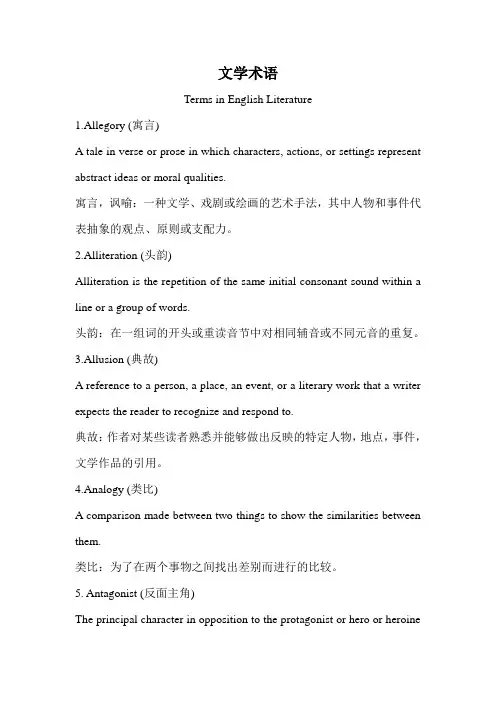
文学术语Terms in English Literature1.Allegory (寓言)A tale in verse or prose in which characters, actions, or settings represent abstract ideas or moral qualities.寓言,讽喻:一种文学、戏剧或绘画的艺术手法,其中人物和事件代表抽象的观点、原则或支配力。
2.Alliteration (头韵)Alliteration is the repetition of the same initial consonant sound within a line or a group of words.头韵:在一组词的开头或重读音节中对相同辅音或不同元音的重复。
3.Allusion (典故)A reference to a person, a place, an event, or a literary work that a writer expects the reader to recognize and respond to.典故:作者对某些读者熟悉并能够做出反映的特定人物,地点,事件,文学作品的引用。
4.Analogy (类比)A comparison made between two things to show the similarities between them.类比:为了在两个事物之间找出差别而进行的比较。
5. Antagonist (反面主角)The principal character in opposition to the protagonist or hero or heroineof a narrative or drama.反面主角:叙事文学或戏剧中与男女主人公或英雄相对立的主要人物。
6. Antithesis (对仗)The balancing of two contrasting ideas, words, or sentences.对仗:两组相对的思想,言辞,词句的平衡。
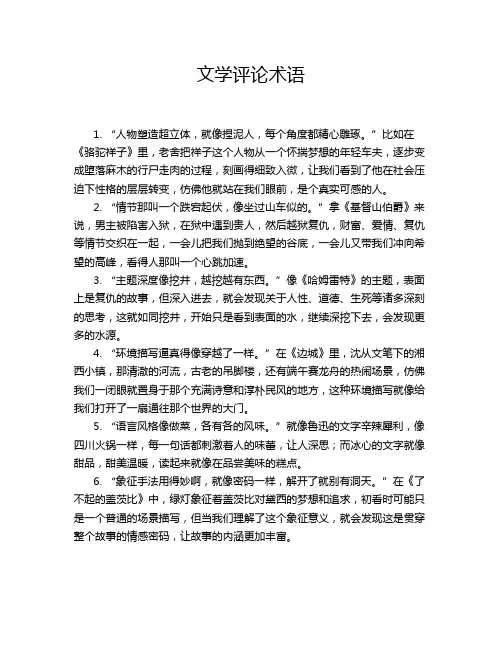
文学评论术语1. “人物塑造超立体,就像捏泥人,每个角度都精心雕琢。
”比如在《骆驼祥子》里,老舍把祥子这个人物从一个怀揣梦想的年轻车夫,逐步变成堕落麻木的行尸走肉的过程,刻画得细致入微,让我们看到了他在社会压迫下性格的层层转变,仿佛他就站在我们眼前,是个真实可感的人。
2. “情节那叫一个跌宕起伏,像坐过山车似的。
”拿《基督山伯爵》来说,男主被陷害入狱,在狱中遇到贵人,然后越狱复仇,财富、爱情、复仇等情节交织在一起,一会儿把我们抛到绝望的谷底,一会儿又带我们冲向希望的高峰,看得人那叫一个心跳加速。
3. “主题深度像挖井,越挖越有东西。
”像《哈姆雷特》的主题,表面上是复仇的故事,但深入进去,就会发现关于人性、道德、生死等诸多深刻的思考,这就如同挖井,开始只是看到表面的水,继续深挖下去,会发现更多的水源。
4. “环境描写逼真得像穿越了一样。
”在《边城》里,沈从文笔下的湘西小镇,那清澈的河流,古老的吊脚楼,还有端午赛龙舟的热闹场景,仿佛我们一闭眼就置身于那个充满诗意和淳朴民风的地方,这种环境描写就像给我们打开了一扇通往那个世界的大门。
5. “语言风格像做菜,各有各的风味。
”就像鲁迅的文字辛辣犀利,像四川火锅一样,每一句话都刺激着人的味蕾,让人深思;而冰心的文字就像甜品,甜美温暖,读起来就像在品尝美味的糕点。
6. “象征手法用得妙啊,就像密码一样,解开了就别有洞天。
”在《了不起的盖茨比》中,绿灯象征着盖茨比对黛西的梦想和追求,初看时可能只是一个普通的场景描写,但当我们理解了这个象征意义,就会发现这是贯穿整个故事的情感密码,让故事的内涵更加丰富。
7. “叙事节奏把握得就像跳舞的节拍,恰到好处。
”例如《老人与海》,海明威没有在开头就把老人的故事一股脑地倒出来,而是缓缓地、有节奏地讲述老人出海、与鱼搏斗的过程,不紧不慢,就像跳慢舞一样,每一个动作都充满力量和韵味。
8. “视角独特得像从外星人的眼睛看地球。
”《百年孤独》采用的那种魔幻现实主义的视角,讲述家族的故事,从布恩迪亚家族的兴起、繁荣到衰落,那种独特的视角就像是一个外星人在俯瞰人类社会的发展,让我们看到了很多平常看不到的东西。
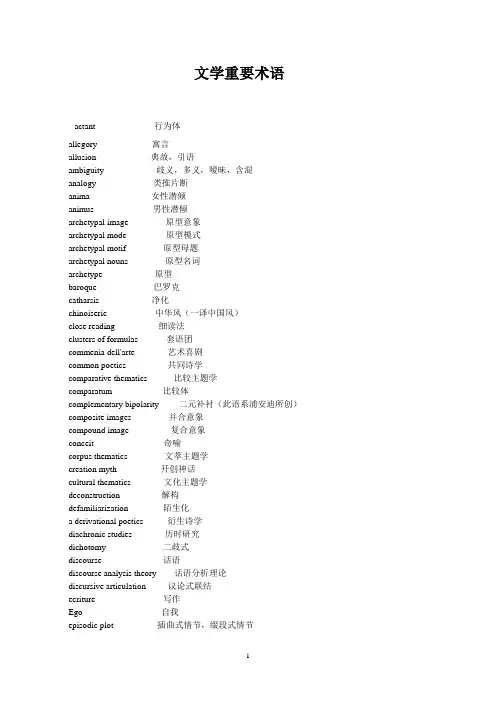
文学重要术语actant 行为体allegory 寓言allusion 典故,引语ambiguity 歧义,多义,暧昧,含混analogy 类推片断anima 女性潜倾animus 男性潜倾archetypal image 原型意象archetypal mode 原型模式archetypal motif 原型母题archetypal nouns 原型名词archetype 原型baroque 巴罗克catharsis 净化chinoiserie 中华风(一译中国风)close reading 细读法clusters of formulas 套语团commenia dell'arte 艺术喜剧common poetics 共同诗学comparative thematics 比较主题学comparatum 比较体complementary bipolarity 二元补衬(此语系浦安迪所创)composite images 并合意象compound image 复合意象conceit 奇喻corpus thematics 文萃主题学creation myth 开创神话cultural thematics 文化主题学deconstruction 解构defamiliarization 陌生化a derivational poetics 衍生诗学diachronic studies 历时研究dichotomy 二歧式discourse 话语discourse analysis theory 话语分析理论discursive articulation 议论式联结ecriture 写作Ego 自我episodic plot 插曲式情节,缀段式情节explicative thematics 阐释主题学extrinsic studies 外部研究fable (有关动物的)寓言fiction 虚构,小说formal realism 形式写实主义formula 套语formulaic expression 套语语句Formulaic Theory 套语理论function 功能genology 文类学genre, or literary genre 文类(即文学类型),体裁heterogeneity 非均一性the High Baroque 鼎盛巴罗克high mimetic 高模仿型Id 本我an illusion of reality 现实的幻象image 意象imagism 意象主义impersonal personality 无个性的个性interdisciplinary study 跨学科研究intersubjectivity 主体间性intertexts 交互文本intertextuality 文本间性irony 反讽itineraria 巡游juxtaposition of imagery 意象并置langue 语言larger-than-life 大于生活lexie 语汇单位leitmotif 主导母题linguistics 语言学linked plot 缀合情节literariness 文学性local texture 局部肌质locus amoenus 安乐之所logical structure 逻辑结构low mimetic 低模仿型the Mannerist style 矫饰主义风格meaning 意旨melodrama 情节剧metacriticism 元批评metafiction 元小说metalanguage 元语言metaphor 暗喻,比喻the Metaphysical style 玄学派风格metonymy 换喻,转喻mirage 幻象model 范型monomyth 单一神话motivation 动因化multiple periodicity 多项周旋(此语系浦安迪所创)mythemes 神话素Mythology 神话体系narrative code 叙事语码narrative syntagms 叙事性横组合段narratology 叙事学objective correlative 客观对应物Oedipus complex 俄狄浦斯情结oral inconsistency 口述出岔overtone 弦外之音(本意为陪音、泛音)oxymoron 矛盾修辞parable 说教寓言paradigmatic 纵聚合的paradox 悖论parody 谐摹parole 言语paronomasia 双关personality 个性,个人性philology 语文学the poetics of discontinuity 非连续诗学point of view 视点pragmatics 语用学the primordial image 原始意象the principle of equivalence 对等原则problematic individuals 疑难人物proseroman 散文传奇pseudo-statement 伪陈述Psychoanalysis 精神分析学raports de fait 实际联系retroactive reading 回味阅读rhapsody 赋saga 英雄传奇semantic formulas 语义套语semantics 语义学semiotics, semiology 符号学shadow 阴影(心理学术语)showing 显示signified 所指signifier 能指simile 明喻Stoffgeschichte 题材史stylistics 风格学Superego 超我symbol 象征symple image 单纯意象synaesthesia 联觉,通感synchronic studies 共时研究syntactic formulas 句法套语syntactics 句法学syntagmatic 横组合的syntax 句法telling 讲述tenor 喻旨tension 张力textuality 本文性thematics, thematology 主题学theme 套式(套语理论所用;暂译名)topoi 惯用话题,老套话tristia 忧郁type scenes 典型场景unitary plot 单一情节vehicle 喻体a vision of reality 现实幻象vorticism 旋涡主义Weniad 文王史诗(此词系王靖献所创)。
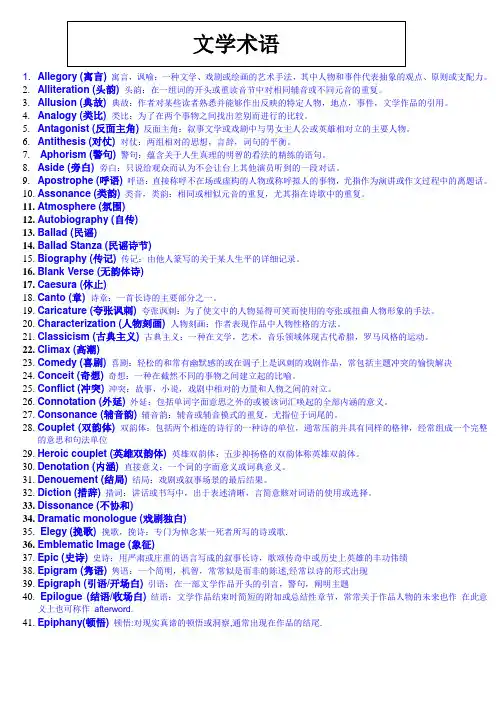
1. Allegory (寓言)寓言,讽喻:一种文学、戏剧或绘画的艺术手法,其中人物和事件代表抽象的观点、原则或支配力。
2.Alliteration (头韵) 头韵:在一组词的开头或重读音节中对相同辅音或不同元音的重复。
3.Allusion (典故) 典故:作者对某些读者熟悉并能够作出反映的特定人物,地点,事件,文学作品的引用。
4.Analogy (类比) 类比:为了在两个事物之间找出差别而进行的比较。
5.Antagonist (反面主角)反面主角:叙事文学或戏剧中与男女主人公或英雄相对立的主要人物。
6.Antithesis (对仗) 对仗:两组相对的思想,言辞,词句的平衡。
7. Aphorism (警句)警句:蕴含关于人生真理的明智的看法的精练的语句。
8.Aside (旁白) 旁白:只说给观众而认为不会让台上其他演员听到的一段对话。
9.Apostrophe (呼语)呼语:直接称呼不在场或虚构的人物或称呼拟人的事物,尤指作为演讲或作文过程中的离题话。
10.Assonance (类韵)类音,类韵:相同或相似元音的重复,尤其指在诗歌中的重复。
11.Atmosphere (氛围)12.Autobiography (自传)13.Ballad (民谣)14.Ballad Stanza (民谣诗节)15.Biography (传记)传记:由他人篆写的关于某人生平的详细记录。
16.Blank Verse (无韵体诗)17.Caesura (休止)18.Canto (章) 诗章:一首长诗的主要部分之一。
19.Caricature (夸张讽刺) 夸张讽刺:为了使文中的人物显得可笑而使用的夸张或扭曲人物形象的手法。
20.Characterization (人物刻画) 人物刻画:作者表现作品中人物性格的方法。
21.Classicism (古典主义) 古典主义:一种在文学,艺术,音乐领域体现古代希腊,罗马风格的运动。
22.Climax (高潮)edy (喜剧)喜剧:轻松的和常有幽默感的或在调子上是讽刺的戏剧作品,常包括主题冲突的愉快解决24.Conceit (奇想)奇想:一种在截然不同的事物之间建立起的比喻。
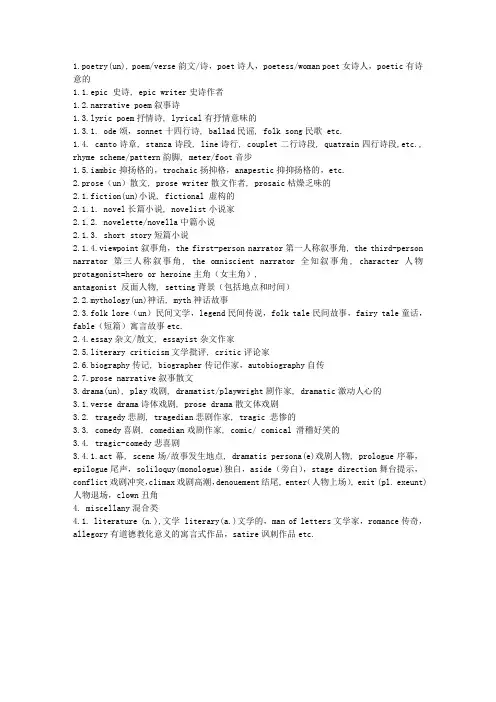
1.poetry(un), poem/verse韵文/诗,poet诗人,poetess/woman poet女诗人,poetic有诗意的1.1.epic 史诗, epic writer史诗作者1.2.narrative poem叙事诗1.3.lyric poem抒情诗, lyrical有抒情意味的1.3.1. ode颂,sonnet十四行诗, ballad民谣, folk song民歌 etc.1.4. canto诗章, stanza诗段, line诗行, couplet二行诗段, quatrain四行诗段,etc., rhyme scheme/pattern韵脚, meter/foot音步1.5.iambic抑扬格的,trochaic扬抑格,anapestic抑抑扬格的,etc.2.prose(un)散文, prose writer散文作者, prosaic枯燥乏味的2.1.fiction(un)小说, fictional 虚构的2.1.1. novel长篇小说, novelist小说家2.1.2. novelette/novella中篇小说2.1.3. short story短篇小说2.1.4.viewpoint叙事角,the first-person narrator第一人称叙事角, the third-person narrator第三人称叙事角, the omniscient narrator全知叙事角, character人物protagonist=hero or heroine主角(女主角),antagonist 反面人物, setting背景(包括地点和时间)2.2.mythology(un)神话, myth神话故事2.3.folk lore(un)民间文学,legend民间传说,folk tale民间故事,fairy tale童话,fable(短篇)寓言故事etc.2.4.essay杂文/散文, essayist杂文作家2.5.literary criticism文学批评, critic评论家2.6.biography传记, biographer传记作家,autobiography自传2.7.prose narrative叙事散文3.drama(un), play戏剧, dramatist/playwright剧作家, dramatic激动人心的3.1.verse drama诗体戏剧, prose drama散文体戏剧3.2. tragedy悲剧, tragedian悲剧作家, tragic 悲惨的3.3. comedy喜剧, comedian戏剧作家, comic/ comical 滑稽好笑的3.4. tragic-comedy悲喜剧3.4.1.act幕, scene场/故事发生地点, dramatis persona(e)戏剧人物, prologue序幕,epilogue尾声,soliloquy(monologue)独白,aside(旁白),stage direction舞台提示,conflict戏剧冲突,climax戏剧高潮,denouement结尾, enter(人物上场), exit (pl. exeunt)人物退场,clown丑角4. miscellany混合类4.1. literature (n.),文学 literary(a.)文学的,man of letters文学家,romance传奇,allegory有道德教化意义的寓言式作品,satire讽刺作品etc.。

中国文学术语集
以下是一些中国文学术语的集合:
1. 诗歌体裁:
- 诗:表达情感、描绘景物和抒发思想的文学形式。
- 词:以短小精悍的形式表达情感的文学形式。
- 曲:以歌唱为主的文学形式。
- 赋:以描写或抒发感情为主的文学形式。
2. 修辞手法:
- 比喻:用一种事物来比喻另一种事物,以增强表达的艺术性和形象性。
- 拟人:赋予非人物以人的特征和行为,增加情感共鸣。
- 夸张:夸大事物的特征或程度,以增强表达的效果。
- 排比:通过列举相同结构的词语或短语来加强表达的力度。
3. 修辞格:
- 对偶:用相同或相似的词语、短语或句子结构来表达对立或相反的意思。
- 反问:用疑问句的形式来表达肯定或否定的意思。
- 押韵:在诗歌中使用相同或相似的音韵来增加韵律感。
4. 现象:
- 平仄:指汉字的声调高低变化。
- 押韵:在诗歌中使用相同或相似的音韵来增加韵律感。
- 韵律:诗歌中的节奏和音乐感。
5. 文学流派:
- 唐诗:盛行于唐朝的诗歌形式,以七言绝句为主要形式。
- 宋词:盛行于宋朝的短小精悍的诗歌形式。
- 元曲:盛行于元朝的戏剧形式,以曲子和对白相结合的形式。
这只是一些中国文学术语的集合,还有许多其他的术语和概念,用于描述和分析中国文学作品和文学创作的特点和风格。
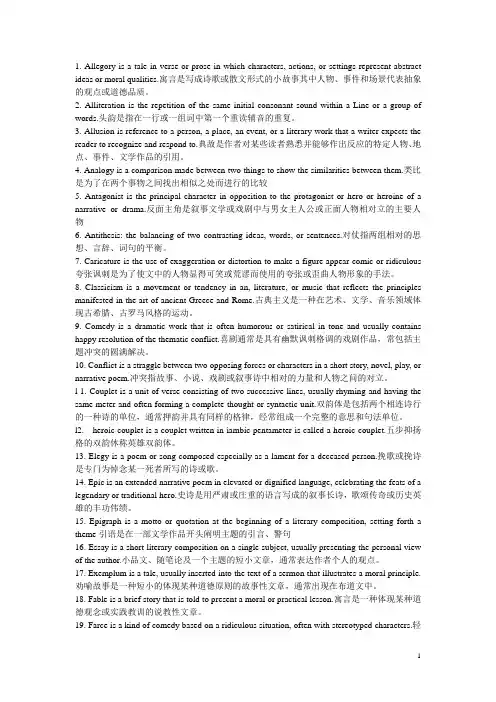
1. Allegory is a tale in verse or prose in which characters, actions, or settings represent abstract ideas or moral qualities.寓言是写成诗歌或散文形式的小故事其中人物、事件和场景代表抽象的观点或道德品质。
2. Alliteration is the repetition of the same initial consonant sound within a Line or a group of words.头韵是指在一行或一组词中第一个重读辅音的重复。
3. Allusion is reference to a person, a place, an event, or a literary work that a writer expects the reader to recognize and respond to.典故是作者对某些读者熟悉并能够作出反应的特定人物、地点、事件、文学作品的引用。
4. Analogy is a comparison made between two things to show the similarities between them.类比是为了在两个事物之间找出相似之处而进行的比较5. Antagonist is the principal character in opposition to the protagonist or hero or heroine of a narrative or drama.反面主角是叙事文学或戏剧中与男女主人公或正面人物相对立的主要人物6. Antithesis: the balancing of two contrasting ideas, words, or sentences.对仗指两组相对的思想、言辞、词句的平衡。
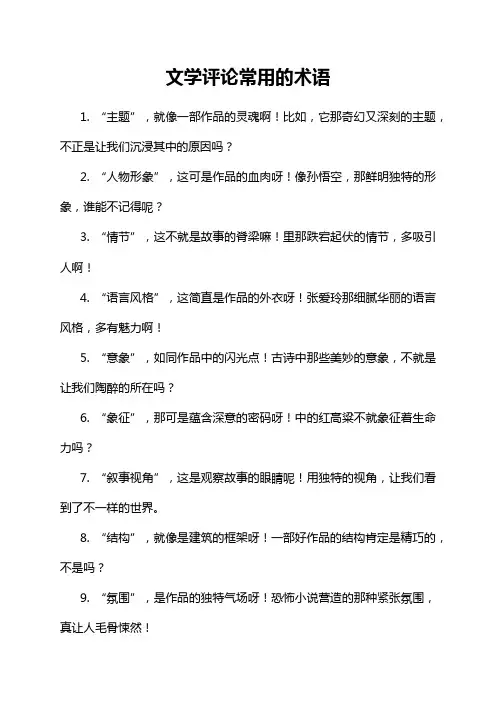
文学评论常用的术语
1. “主题”,就像一部作品的灵魂啊!比如,它那奇幻又深刻的主题,不正是让我们沉浸其中的原因吗?
2. “人物形象”,这可是作品的血肉呀!像孙悟空,那鲜明独特的形象,谁能不记得呢?
3. “情节”,这不就是故事的脊梁嘛!里那跌宕起伏的情节,多吸引人啊!
4. “语言风格”,这简直是作品的外衣呀!张爱玲那细腻华丽的语言风格,多有魅力啊!
5. “意象”,如同作品中的闪光点!古诗中那些美妙的意象,不就是让我们陶醉的所在吗?
6. “象征”,那可是蕴含深意的密码呀!中的红高粱不就象征着生命力吗?
7. “叙事视角”,这是观察故事的眼睛呢!用独特的视角,让我们看到了不一样的世界。
8. “结构”,就像是建筑的框架呀!一部好作品的结构肯定是精巧的,不是吗?
9. “氛围”,是作品的独特气场呀!恐怖小说营造的那种紧张氛围,真让人毛骨悚然!
10. “寓意”,这可是作品的深层内涵呢!里的寓意,多给人启发啊!
我觉得这些文学评论常用术语就像一把把钥匙,能帮我们更好地打开文学作品的大门,深入领略其中的美妙。
文学类文本艺术特色的相关术语1. 细腻入微:就像画家一笔一笔勾勒出精致的画面一样,文学作品中的细腻入微能把每个小细节都描绘得清清楚楚。
比如在《背影》里,朱自清描写父亲翻过月台去买橘子的背影,那臃肿的身躯、蹒跚的脚步,每一个动作都写得细致极了,仿佛这个场景就在眼前重现,让人感受到父爱的深沉,真的很感人呢。
2. 生动逼真:这就好比是把活生生的场景直接搬到了纸上。
像《孔乙己》中对孔乙己的描写,“他身材很高大;青白脸色,皱纹间时常夹些伤痕;一部乱蓬蓬的花白的胡子。
穿的虽然是长衫,可是又脏又破,似乎十多年没有补,也没有洗。
”这么一读,孔乙己这个人就像站在我们面前一样,活灵活现的,是不是很厉害?3. 含蓄蕴藉:有些话不直接说出来,就像把宝藏埋在地下,等着读者自己去挖掘。
拿李商隐的诗来说,“春蚕到死丝方尽,蜡炬成灰泪始干。
”表面上是说春蚕和蜡烛,实际上是在表达那种深深的思念和奉献精神,你要是不细细品味,还真不容易发现这层深意呢。
4. 诙谐幽默:读这样的作品就像看喜剧一样,让人忍不住发笑。
马克·吐温的作品就充满了这种诙谐幽默。
他在《汤姆·索亚历险记》里,汤姆被罚刷墙,却能想出办法让别的孩子心甘情愿地替他干活,还觉得这是一种荣幸,这种描写充满了童趣和幽默,让我们在阅读的时候心情特别轻松愉快。
5. 雄浑壮阔:就像是站在高山之巅,眺望那无尽的山河,给人一种大气磅礴的感觉。
比如李白的《蜀道难》,“上有六龙回日之高标,下有冲波逆折之回川。
黄鹤之飞尽,猿猱欲度愁攀援。
”那对蜀道险峻的描写,读起来就让人觉得气势恢宏,内心也跟着澎湃起来。
6. 婉约柔美:像江南水乡的女子,温柔细腻。
李清照的词就是这种风格,“莫道不销魂,帘卷西风,人比黄花瘦。
”把那种思念和淡淡的哀愁,用这么婉约的方式表达出来,仿佛能看到一个女子在秋风中独自惆怅的画面,真的很让人心疼。
7. 象征手法:就像是用一个东西来代表另一个更深层次的东西。
基本文学术语1. A llegory(寓言)A narrative that serves as an extended metaphor. The main purpose of an allegory is to tell a story that has characters, a setting, as well as other types of symbols, which have both literaland figurative meanings.2. Allusion (引喻)A reference in a literary work to a person, place, or thing in history or another work of literature. Allusions are often indirect or brief references to well-known character or events.3. Archetype(原型)Commonly used to describe an original pattern or model from which all other things of the same kind are made.4. Black Humor(黑色幽默)Also known as Black Comedy, writing that places grotesque element- side by side with humorous ones in an attempt to shock the reader, forcing him or her to laugh at the horrifying reality of a disordered world.5. Classicism(古典主义)A term used in literary criticism to describe critical doctrines that have their roots in ancient Greek and Roman literature, philosophy, and art. Works associated with classicism typically exhibit restraint on the part of the author, unity of design and purpose, clarity, simplicity, logical organization, and respect for tradition.6. Existentialism (存在主义)A predominantly twentieth-century philosophy concerned with the nature and perception of human existence. There are two major strains of existentialist thought: atheistic and Christian. Followers of atheistic existentialism believe that the individual is alone in a godless universe and that the basic human condition is one of suffering and loneliness. Nevertheless, because there are no fixed values, individuals can create their own characters — indeed, they can shape themselves — through the exercise of free will.7. Expressionism (表现主义)An indistinct literary term originally used to describe an early twentieth-century school of German painting. The term applies to almost any mode of unconventional, highly subjective writing that distorts reality in some way.8. Formalism (形式主义)In literary criticism, the belief that literature should follow prescribed rules of construction, such as those that govern the sonnet form.9. Imagism (意象派)An English and American Poetry movement that flourished between 1908 and 1917. The 1magists used precise, clearly presented images in their works. They also used common, everyday speech and aimed for conciseness, concrete imagery, and the creation of new rhythms.10. Irony (反讽)In literary criticism, the effect of language in which the intended meaningis the opposite of what is stated.11. Lost Generation (迷惘的一代)A term first used by Gertrude Stein to describe the post-World War I generation ofAmerican writers: men and women haunted by a sense of betrayal and emptiness broughtabout by the destructiveness of the war. (To Be Continued)12. Metaphor (暗喻、隐喻)A figure of speech that expresses an idea through the image of another object. Metaphors suggest the essence of the first object by identifying it with certain qualities of the second object.13. Modernism (现代主义)Modern literary practices. Also, the principles of a literary school that lasted from roughlythe beginning of the twentieth century until the end of World War II. Modernism is definedby its rejection of the literary conventions of the nineteenth century and by its opposition to conventional morality, taste, traditions, and economic values.14. Naturalism (自然主义)A literary movement of the late nineteenth and early twentieth centuries. The Naturalists typically viewed human beings as either the products of "biological determinism" , ruled by hereditary instincts and engaged in an endless struggle for survival, or as the products of " socioeconomic determinism" , ruled by social and economic forces beyond their control.15. Neoclassicism (新古典主义)In literary criticism, this term refers to the revival of the attitudes and styles of expression of classical literature. It is generally used to describe a period in European history beginning in the late seventeenth century and lasting until about 1800. In its purest from, Neoclassicism marked a return to order, proportion, restraint, logic, accuracy, and decorum.16. Postmodenism (后现代主义)Writing from the 1960s forward characterized by experimentation and continuing to apply some of the fundamentals of modernism, which included existentialism and alienation. Postmodernists have gone a step further in the rejection of tradition begun with the modernists by also rejecting traditional forms, preferring the anti-novel over the novel and the anti-hero over the hero.17. Realism(现实主义)A nine teenth-century European literary movement that sought to portray familiar characters, situations, and settings in a realistic manner. This was done primarily by using an objective narrative point of view and through the buildup of accurate detail. The standard for success of any realistic work depends on how faithfully it transfers common experience into fictional forms.18. Romanticism (浪漫主义)A general term to refer to a type of sensibility found in all periods of literary history and usually considered to be in opposition to the principles of classicism. In this sense, Romanticism signifies any work or philosophy in which the exotic or dreamlike figure strongly, or that is devoted to individualistic expression, self-analysis, or a pursuit of a higher realm of knowledge than can be discovered by human reason.19. Symbolism(象征主义)The term refers to the use of one object to represent another.20. Transcendentalism(超验主义)An American philosophical and religious movement, based in New England from around 1835 until the Civil War. The Transcendentalists stressed the importance of intuition and subjective experience in communication with God. They rejected religious dogma and texts in favor of mysticism and scientific naturalism.。
文学名词解释文学名词是用来描述文学作品、文学现象或文学理论的专门术语。
以下是一些常见的文学名词的解释:1. 小说:一种长篇故事性的文学作品,通常包含人物、情节和背景设置。
2. 诗歌:一种利用韵脚、节奏和意象等修辞手法表达思想和情感的文学形式。
3. 戏剧:一种通过角色的对话和行动来表达情节、观点和主题的文学作品,也可以指演出的艺术形式。
4. 散文:一种不使用诗歌形式的散文作品,以叙事、描写和议论为特点。
5. 史诗:一种叙述英雄传奇或重大历史事件的叙事诗歌形式。
6. 寓言:一种通过虚构的故事来传递道德或寓意的文学形式,常常包含人物化的动物或物体。
7. 韵文:一种使用韵脚的诗歌形式。
8. 抒情诗:一种表达作者个人情感和体验的诗歌形式。
9. 叙事诗:一种通过叙述来讲述故事或事件的诗歌形式。
10. 渲染:一种通过描写细节和氛围来表达情感或场景的文学技巧。
11. 刻画:一种通过描写人物的外貌、个性、思想和情感来使其栩栩如生的文学技巧。
12. 比喻:一种通过将一个事物与另一个事物进行类比来传递意义的修辞手法。
13. 暗示:一种通过暗示或间接暗示来传递意义或创造悬念的修辞手法。
14. 反讽:一种通过用词或语气的反差来传递愤怒、嘲笑或讽刺的修辞手法。
15. 典型:一种具有普遍性和代表性的文学人物、情节或主题。
16. 悬念:一种通过悬而未决的情节发展来引发读者的紧张感和好奇心的文学技巧。
17. 主题:一种作品中表达的基本思想、观点或价值观。
18. 道德:一种在作品中传递的道德准则或价值观。
19. 简洁:一种通过言简意赅地表达思想和情感的文学风格。
20. 风格:作家独特的写作方式,包括词语选择、句法结构和修辞手法等。
这些文学名词的解释可以帮助读者更好地理解和欣赏文学作品,同时也可以用于文学研究和批评中。
纯文学作者术语纯文学作者术语是指文学作者在写作过程中使用的一些特殊术语,它们可以帮助作者更好地表达自己的想法,更有效地传达文字的意义。
首先,纯文学作者术语包括文学作者使用的一些特殊词汇,如比喻、拟人、夸张、象征等。
比喻是指用一种物体来比拟另一种物体,以表达某种抽象的概念,如“他的心如钢铁般坚定”;拟人是指把某种物体或概念比作人,以表达某种抽象的概念,如“春天的脚步轻盈”;夸张是指用超出实际的语言来表达某种抽象的概念,如“他的智慧无可匹敌”;象征是指用某种物体来表达某种抽象的概念,如“白云象征着希望”。
其次,纯文学作者术语还包括文学作者使用的一些特殊句式,如排比、比喻句、拟人句、夸张句、象征句等。
排比是指用相同的句式把几个句子连接起来,以表达某种抽象的概念,如“他勤奋学习,刻苦钻研,不达目的,誓不罢休”;比喻句是指用比喻的方式来表达某种抽象的概念,如“他的心如钢铁般坚定”;拟人句是指用拟人的方式来表达某种抽象的概念,如“春天的脚步轻盈”;夸张句是指用夸张的方式来表达某种抽象的概念,如“他的智慧无可匹敌”;象征句是指用象征的方式来表达某种抽象的概念,如“白云象征着希望”。
最后,纯文学作者术语还包括文学作者使用的一些特殊修辞手法,如排比修辞、比喻修辞、拟人修辞、夸张修辞、象征修辞等。
排比修辞是指用排比的方式来表达某种抽象的概念,如“他勤奋学习,刻苦钻研,不达目的,誓不罢休”;比喻修辞是指用比喻的方式来表达某种抽象的概念,如“他的心如钢铁般坚定”;拟人修辞是指用拟人的方式来表达某种抽象的概念,如“春天的脚步轻盈”;夸张修辞是指用夸张的方式来表达某种抽象的概念,如“他的智慧无可匹敌”;象征修辞是指用象征的方式来表达某种抽象的概念,如“白云象征着希望”。
总之,纯文学作者术语是文学作者在写作过程中使用的一些特殊术语,它们可以帮助作者更好地表达自己的想法,更有效地传达文字的意义。
文学理论术语小辞典(仅供内部参考使用)目录目录 (I)1 .文学四要素 (1)2 .摹仿说 (1)3 .观物取象说 (1)4 .表现说 ......................................................................................................... 15 .言志说 (1)6 .文学本体论 (1)7 .劳动说 (1)8 .不平衡说 (1)9 .循环说 (1)10 .文学三义 (1)11 .话语 (1)12 .审美无功利性 (2)13 .直觉 (2)14 .文学的审美意识形态性质 (2)15 .文学的双重性质 (2)16 .话语蕴藉 (2)17 .含蓄与含混 (2)18 .文学 (2)19 .文学创造材料 (2)20 .艺术发现 (2)21 .创作动机 (2)22 .艺术构思 (2)23 .回忆与沉思 (2)24 .想象与联想 (3)25 .灵感与直觉 (3)26 .理智与情感 (3)27 .意识与无意识 (3)28 .综合 (3)29 .突出和简化 (3)30 .变形与陌生化 (3)31 .即兴与推敲 (3)32 .现实型文学 (4)33 .理想型文学 (4)34 .象征型文学 (4)35 .浪漫主义文学 (4)36 .现实主义文学 (4)37 .象征主义文学 (4)38 .现代主义文学 (4)39 .诗 (4)40 .小说 (4)41 .剧本 (4)42 .散文 ........................................................................................................... 543 .报告文学 (5)44 .文学本文三层次 (5)45 .文学话语的特征 (5)46 .文学形象及其特征 (5)47 .文学意蕴及其层次 (5)48 .文学典型 (5)49 .文学意境 (5)50 .情景交融 (5)51 .虚实相生 (5)52 .韵味无穷 (6)53 .审美意象 (6)54 .叙事 (6)55 .叙事的构成 (6)56 .本文时间和故事时间 (6)57 .时序 (6)58 .时长 (6)59 .频率 (6)60 .叙述视角 (6)61 .叙述动作 (6)62 .叙述者 (6)63 .拟想接受者 (6)64 .抒情及其特征 (7)65 .宣泄 (7)66 .抒情内容与抒情话语 (7)67 .声与情 (7)68 .景与情 (7)69 .抒情方式 (7)70 .抒情角色 (8)71 .风格 (8)72 .创作个性 (8)73 .话语情境 (8)74 .文学风格的特性 (8)75 .文学风格的形态 (8)76 .文学消费的二重性 (8)77 .期待视野 (8)78 .接受动机 (8)79 .接受心境 (8)80 .隐含的读者 ............................................................................................... 881 .填空、对话与兴味 .. (8)82 .还原与异变 (9)83 .理解与误解 (9)84 .期待遇挫 (9)85 .共鸣 (9)86 .净化 (9)87 .领悟 (9)88 .延留 (9)1 .文学四要素。
文学术语Terms in English Literature1.Allegory (寓言)A tale in verse or prose in which characters, actions, or settings represent abstract ideas or moral qualities.寓言,讽喻:一种文学、戏剧或绘画的艺术手法,其中人物和事件代表抽象的观点、原则或支配力。
2.Alliteration (头韵)Alliteration is the repetition of the same initial consonant sound within a line or a group of words.头韵:在一组词的开头或重读音节中对相同辅音或不同元音的重复。
3.Allusion (典故)A reference to a person, a place, an event, or a literary work that a writer expects the reader to recognize and respond to.典故:作者对某些读者熟悉并能够作出反映的特定人物,地点,事件,文学作品的引用。
4.Analogy (类比)A comparison made between two things to show the similarities between them. 类比:为了在两个事物之间找出差别而进行的比较。
5. Antagonist (反面主角)The principal character in opposition to the protagonist or hero or heroine of a narrative or drama.反面主角:叙事文学或戏剧中与男女主人公或英雄相对立的主要人物。
6. Antithesis (对仗)The balancing of two contrasting ideas, words, or sentences.对仗:两组相对的思想,言辞,词句的平衡。
7. Aphorism (警句)A concise, pointed statement expressing a wise or clever observation about life.警句:蕴含关于人生真理的明智的看法的精练的语句。
8. Aside (旁白)A piece of dialogue intended for the audience and supposedly not heard by other actors on stage.旁白:只说给观众而认为不会让台上其他演员听到的一段对话。
9.Apostrophe (呼语)The direct address of an absent or imaginary person or of a personified abstraction, especially as a digression in the course of a speech or composition.呼语:直接称呼不在场或虚构的人物或称呼拟人的事物,尤指作为演讲或作文过程中的离题话。
10.Assonance (类韵)The repetition of similar vowel sounds, especially in poetry.类音,类韵:相同或相似元音的重复,尤其指在诗歌中的重复。
11.Atmosphere (氛围)The prevailing mood or feeling of a literary work.12. Autobiography (自传)A person‘s account of his or her own life.13. Ballad (民谣)A narrative poem, often of folk origin and intended to be sung.14. Ballad Stanza (民谣诗节)A type of four-line stanza, the first and the third lines have four stressed words or syllables; the second and fourth lines have three stresses.15. Biography (传记)A detailed account of a person‘s life written by another person.传记:由他人篆写的关于某人生平的详细记录。
16.Blank Verse (无韵体诗)Verse written in unrhymed iambic pentameter.17. Caesura (休止)A break or pause in a line of poetry.18. Canto (章)One of the principal divisions of a long poem..诗章:一首长诗的主要部分之一。
19. Caricature (夸张讽刺)The use of exaggeration or distortion to make a figure appear comic or ridiculous.夸张讽刺:为了使文中的人物显得可笑而使用的夸张或扭曲人物形象的手法。
20. Characterization (人物刻画)The means by which a writer reveals the personality of a character.人物刻画:作者表现作品中人物性格的方法。
21. Classicism (古典主义)A movement or tendency in art, literature, or music that reflects the principles manifested in the art of ancient Greece and Rome.古典主义:一种在文学,艺术,音乐领域体现古代希腊,罗马风格的运动。
22. Climax (高潮)The point of greatest intensity, interest, or suspense in a narrative.23. Comedy (喜剧)A dramatic work that is often humorous or satirical in tone and usually contains a happy resolution of the thematic conflict.喜剧:轻松的和常有幽默感的或在调子上是讽刺的戏剧作品,常包括主题冲突的愉快解决24. Conceit (奇想)A kind of metaphor that makes a comparison between two startlingly different things.奇想:一种在截然不同的事物之间建立起的比喻。
25. Conflict (冲突)A struggle between two opposing forces or characters in a short story, novel, play, or narrative poem.冲突:故事,小说,戏剧中相对的力量和人物之间的对立。
26. Connotation (外延)All the emotions and associations that a word or phrase may arouse.外延:包括单词字面意思之外的或被该词汇唤起的全部内涵的意义。
27. Consonance (辅音韵)The repetition of consonants or a consonant pattern, especially at the ends of words.辅音韵:辅音或辅音模式的重复,尤指位于词尾的。
28. Couplet (双韵体)A unit of verse consisting of two successive lines, usually rhyming and having the same meter and often forming a complete thought or syntactic unit. 双韵体:包括两个相连的诗行的一种诗的单位,通常压韵并具有同样的格律,经常组成一个完整的意思和句法单位29. Heroic couplet (英雄双韵体)A couplet written in iambic pentameter is called a heroic couplet.英雄双韵体:五步抑扬格的双韵体称英雄双韵体。
30. Denotation (内涵)The literal or dictionary meaning of a word.直接意义:一个词的字面意义或词典意义。
31. Denouement (结局)The final resolution or clarification of a dramatic or narrative plot. 结局:戏剧或叙事场景的最后结果。
32. Diction (措辞)A writer‘s choice and use of words in speech or writing, particularly for clarity, effectiveness, and precision.措词:讲话或书写中,出于表述清晰,言简意赅对词语的使用或选择。
33. Dissonance (不协和)A harsh or disagreeable combination of sounds; discord.34. Dramatic monologue (戏剧独白)A kind of narrative poem in which one character speaks to one or more listeners whose replies are not given in the poem.35. Elegy (挽歌)A poem or song composed especially as a lament for a deceased person.挽歌,挽诗:专门为悼念某一死者所写的诗或歌.36. Emblematic Image (象征)A verbal picture of figure with a long tradition of moral or religious meaning attached to it.37. Epic (史诗)An extended narrative poem in elevated or dignified language, celebrating the feats of a legendary or traditional hero.史诗:用严肃或庄重的语言写成的叙事长诗,歌颂传奇中或历史上英雄的丰功伟绩38. Epigram (隽语)A concise, clever, often paradoxical statement, susally in the form of a poem.隽语:一个简明,机智,常常似是而非的陈述,经常以诗的形式出现39. Epigraph (引语/开场白)A motto or quotation at the beginning of a literary composition, setting forth a theme.引语:在一部文学作品开头的引言,警句,阐明主题40. Epilogue (结语/收场白)A short addition or concluding section at the end of a literary work, often dealing with the future of its characters. Also called In this sense, also called afterword结语:文学作品结束时简短的附加或总结性章节,常常关于作品人物的未来也作在此意义上也可称作 afterword.41. Epiphany(顿悟)A moment of illumination, usually occurrs at or near the end of a work. 顿悟:对现实真谛的顿悟或洞察,通常出现在作品的结尾.42. Epitaph(墓志铭)An inscription on a tombstone or in a short poem in memory of someone who has been dead.墓志铭:刻于墓碑上用以怀念死者的碑铭.43. Epithet (表述词语)A term used to characterize a person or thing。